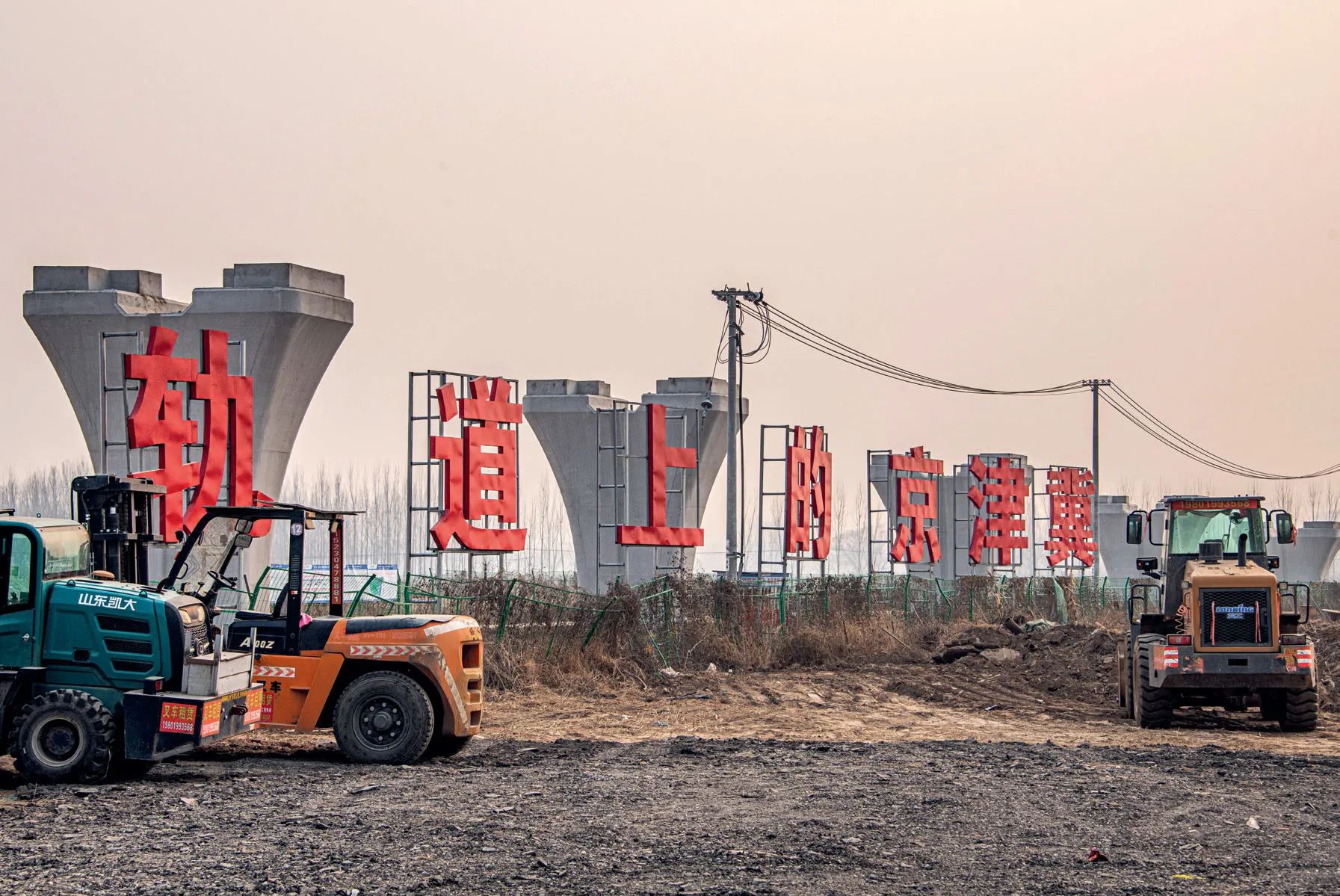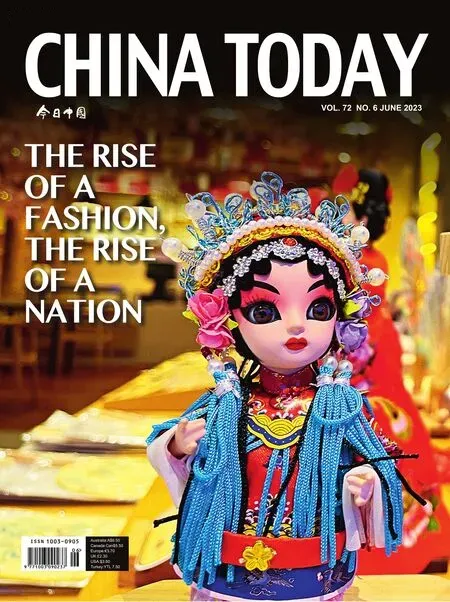A Foretaste of What Chinese Modernization Promises
By CHINA TODAY
President Xi Jinping’s inspection tour of Hebei to promote coordinated Beijing-Tianjin-Hebei development underlines the region’s pursuit of Chinese modernization.
SOON after China completed its First Centenary Goal to build a moderately prosperous society in all respects when the Communist Party of China (CPC)celebrated its 100th anniversary in 2021,“Chinese modernization” became a phrase on everyone’s lips around the country.As its Second Centenary Goal is to become a great modern socialist country in all respects and further advance the nation’s comprehensive rejuvenation along a Chinese path to modernization,this topic has sparked discussion in all quarters.
What does Chinese modernization look like?The coordinated development of the Beijing-Tianjin-Hebei region presents a preview of China’s vision in that respect.

Chinese President Xi Jinping greets the residents while visiting a residential community in Rongdong District of Xiong’an New Area,north China’s Hebei Province,on May 10,2023.
“City of the Future” in the Making
Xiong’an New Area,located about 100 km southwest of Beijing and officially established on April 1,2017,is now entering its large-scale construction phase.Convenient transportation,new and skillfully located residential communities in an improved ecological environment,and upgraded public services have paved the way to the birth of a new modern city,Xiong’an.
During his recent inspection tour in May,President Xi Jinping remarked that the development of Xiong’an New Area had reached a point of acknowledging the dual importance of its large-scale construction and ultimate purpose of relieving Beijing,in its role as national capital,of non-essential functions.
As part of the strategic coordinated development vision of the Beijing-Tianjin-Hebei area,Xiong’an is positioned as an integral component of the Beijing-Tianjin-Hebei city cluster in taking over Beijing’s non-essential functions and thus constituting a Chinese solution to the so-called big city malaise of overcrowding,pollution,and traffic congestion.In other words,as President Xi earlier stated,“We should strengthen the core function of Beijing as a capital city,and transfer those incongruous to the capital’s status to Hebei and Tianjin.”
Located in Hebei Province,and in line with the country’s high-quality development path,Xiong’an New Area,spanning Xiongxian,Rongcheng,and Anxin counties,and other adjacent areas,is envisioned as a world-class innovative,green and smart city of blue skies,fresh air,and clear water.The construction of Xiong’an is regarded as “a strategy of lasting importance for the millennium to come,and a significant national event.”
Consistent efforts will go into constructing a multidimensional,comprehensive transport network through optimal use of underground space,in a bid to build a city of the future that is free of“urban problems,” Xi said during his recent inspection tour.
The Beijing-Xiong’an Intercity Railway broke ground on February 28,2018,and came into full operation on December 27,2020.It created a new high-speed corridor for rail traffic,having reduced the travel time from Xiong’an New Area to Beijing West Railway Station from 90 minutes to about 50 minutes,and the journey to the capital’s Daxing International Airport to only 19 minutes.To fulfil its aim of becoming a digital and smart city,Xiong’an carries out road-tests for autonomous buses in its Rongdong area,site of 153 km of “digital roads.” Here,the sensors on 6,000 or more lamp poles give support to self-driving,and also monitor traffic to help reduce traffic jams,according to Yuexiang Xiong’an Company that specializes in smart transport and unmanned driving.
Six years on,the Xiong’an New Area blueprint is fast becoming reality as this high-level modern city takes shape.Xiong’an has used a total investment of over RMB 540 billion,and completed a developed area of approximately 120 square km on which 3,500 or more buildings have been constructed.China’s centrally-administered stateowned enterprises (SOEs) have set up more than 140 subsidiaries and branches in the area,and 3,000 or more of the enterprises registered in Xiong’an have a background of investment in Beijing.
Xi emphasized during his recent inspection the importance of innovation-driven development in the area.Xiong’an is building itself into an innovation hub while attracting ever more high-caliber talent.The Chinese Academy of Sciences has set up its Xiong’an innovation and research institute,and many other technological companies have either established their presence or headquartered themselves in the area.Li Qiang,general manager of the AI company Eyecool’s Xiong’an branch,regards Xiong’an as a testing ground for technological innovation that increasingly features blockchain,AI,and digital road applications.
Harmony between human society and nature is another hallmark of this “city of the future”with its blue skies,clear water,and pleasant natural environment.A massive afforestation project launched in 2017 culminated in Xiong’an’s afforestation of over 31,000 hectares of land,increasing its forest coverage rate from 11 percent to 34 percent.Local residents live within one km from a tree belt and three km from a forest.
There has moreover been a significant improvement in the water quality of Xiong’an New Area’s Baiyangdian Lake,the largest wetland ecosystem in northern China,over the past several years.Meanwhile,wild bird species in the lake area have increased to 252,46 more than six years ago.
Pioneer of Chinese Modernization
During his recent inspection tour of Hebei Province President Xi called for efforts to elevate the coordinated development of the Beijing-Tianjin-Hebei region and to make it a pioneer and exemplar of Chinese modernization.
The strategy was first proposed nine years ago,with the aim of building a future-oriented capital economic circle,promoting coordinated regional development,and improving the region’s city cluster.Coordinated regional development is now in full swing,and has become an important driving force for the country’s development.
The Beijing-Tianjin-Hebei region’s gross domestic product (GDP) capped RMB 10 trillion in 2022,representing,at current prices,a 1.8-fold increase over that of 2013,according to a report released on February 20 by Beijing Municipal Bureau of Statistics.

A rail line is under construction in Xiong’an New Area,Hebei Province,on February 26,2023.It will be part of the rail network which will bond Beijing,Tianjin,and Hebei more closely by providing convenient transportation.
Relieving non-capital functions and coordinating regional development has improved the region’s industrial layout,making resource distribution more balanced and development more innovation driven.This transformation is benefiting the whole Beijing-Tianjin-Hebei region.
While chairing a meeting on May 12 in Shijiazhuang City on promoting coordinated development of the Beijing-Tianjin-Hebei region President Xi called on Hebei Province to blaze new paths in its pursuit of innovation-driven development.In referring to the obvious achievements of the Beijing-Tianjin-Hebei region’s coordinated development,Xi observed that efforts to relieve Beijing of functions non-essential to its role as the national capital are paying off.“Major progress has been made in building the region into a beautiful and livable place,and technological innovation and industrial integration have been constantly improved,” Xi said.Facts prove that the regional development strategy is an effective approach to promoting Chinese modernization.
Xi noted that the Beijing-Tianjin-Hebei region constitutes three of the most important drivers of China’s high-quality development,by virtue of its numerous first-class institutions of higher learning and high-caliber talent engaged in research,as well as strong and solidly-based innovation capability.The region should strengthen its innovation coordination and industrial collaboration in order to play an exemplary role in achieving self-reliance in high-level science and technology,Xi concluded.
The Beijing-Tianjin-Hebei region invested a total of RMB 394.91 billion in R&D in 2021,2.1 times that in 2013,and accounting for 14.1 percent of the national total,according to National Bureau of Statistics (NBS) data.
Xi stressed that the coordinated development of the Beijing-Tianjin-Hebei region should ultimately improve the people’s wellbeing and promote common prosperity.He went on to emphasize the importance of sharing Beijing and Tianjin’s high-quality primary and secondary education resources with Hebei,and of developing health care consortia and extending elderly care programs in Beijing and Tianjin to eligible areas in Hebei.He also highlighted the work on key ecological conservation and restoration projects in northern China,along with such major ecological projects as the building of ecological shields.
Today,Beijing and Tianjin’s exchanges of basic education programs with Hebei number more than 500.And the 22 university development alliances established in the region are expected to balance educational resources and provide students with equitable opportunities.Meanwhile,the triad’s 685 medical institutions accept one another’s clinical test results.
The region,moreover,saw an improvement in both its air quality and a more sustainable energy mix in 2021.The average PM2.5 (fine particulate matter that causes smog) density fell 15.6 percent year-on-year,and renewable energy accounted for 8.8 percent of the region’s total energy consumption,up 1.9 percentage points from 2020,according to the NBS.
(Based on reports of agencies)

